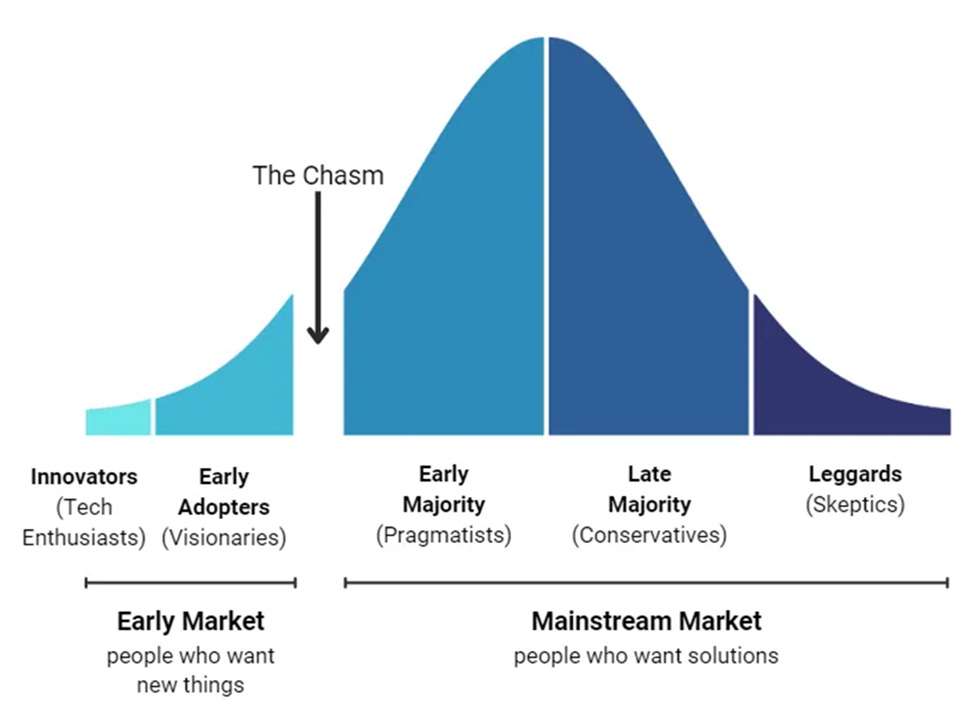When it comes to AI, there’s a new pathway to “Crossing the Chasm”
Follow the discussion on LinkedIn and X.com
I’ve long been a HUGE fan of Geoffrey Moore’s book “Crossing the Chasm”. That said, as we work with more and more AI companies, we are witnessing a fundamental breakdown in the customer behavior that Geoffrey observes and reports on.
For those that haven’t read the book, Geoffrey Moore emphasizes that the success of innovative products depends on capturing a specific segment of the market before mainstream adoption can occur. The belief is that “Early Adopters” are the visionaries who are willing to take risks on new technologies because they see the potential for a significant competitive advantage or transformation. Unlike the mainstream market (such as mid-market / enterprise buyers) that seek ample validation, early adopters are hobby enthusiasts in technology allowing them to gain conviction faster. Moore argues that startups should focus on winning over these early adopters first, using their enthusiasm and feedback to refine the product and build credibility, creating a bridge—or “chasm”—toward the larger, more risk-averse majority.
Historically, we’d always seen startups as the early adopters for new entry products. After all, these customers are visionaries themselves - they are other startups who understand the need to embrace the unproven to gain an edge on the competition. They evangelize the lack of bureaucracy as a means to “move fast and break things”, allowing them to sign up as customers earlier than others.
In vertical AI, however, that doesn’t seem to be the case. Perhaps it’s the competitive threats of new AI upstarts potentially competing with maturing startups, or the vapid urgency of today’s corporate environment, but more often than not, we are seeing legacy institutions as the early adopters for our products. These institutions are committing early, dedicating real budget, and sprinting through implementations. This starkly contrasts with the behavior we are seeing by some (not all) of the startups that we partner with that are often: 1) very low willingness to pay, 2) overly protective of their IP and resistant to rely on others (often to their own detriment) and 3) insist on high service level requirements above and beyond what enterprise customers do.
This isn’t specific to a single one of our 4 sectors, it’s a general observation across the companies we work with across each of our verticals. While these startups have often been the foundation for other startups to launch themselves across the chasm, we’re seeing an increasingly wide chasm between today’s AI upstarts and others that matured prior to the more recent advancements, buzz and funding available via AI. Candidly, we think this is a flawed approach. Being a mature startup is harder than ever before - fundraising markets are categorically focused on AI, credit markets have dried up and the bar for going public has increased. In our opinion, you should be doing ANYTHING you can to get ahead, especially partnering with the latest and greatest AI specialists to get additional leverage for your business and to cut your burn.
We’re seeing several in our portfolio who were once ardently focused on building their own vertical tools (largely upon the belief that their tech stack was their core defining characteristic), now pivot into a much more hospitable posture to other vertical AI startups that can help them widen the moats they have over legacy competitors with very successful results. This requires those companies to put their egos on the shelf and realize that today’s modern business models aren’t about the application interfaces you’ve developed, but the networks, customers and data that you have accumulated over the life of your business. For startups, I would embrace ANYTHING that enables you to further amplify those existing assets…if not, the legacy incumbents (who often have broader distribution and troves of underutilized data) will.


